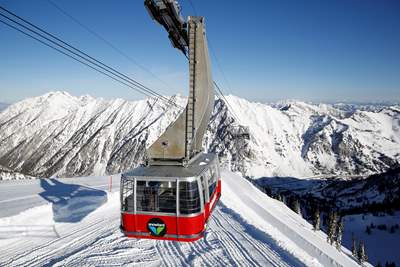When Turns Are About Adaptability, Not Disability
There’s more than one way to get down the mountain.

"I’ve looked at life from both sides now."
– Joni Mitchell
January 1972. The Snowbird Tram door opened, and when I stepped onto the summit of 11,000-foot Hidden Peak, I couldn’t breathe. It had nothing to do with the thin air. It’s because I wasn’t prepared for the magnificence surrounding me — piercing blue skies, snow-covered granite peaks and below me, an endless array of untracked ski runs. I was about to be one of the first lucky souls to dive into the steep and deep powder that graced this soon-to-be-a-legend ski mountain.
My guide was brother-in-law Bob Smith, a Snowbird ski instructor who invited me to join him at this two-day-old resort. At the time I was a ski instructor at Beaver Mountain and a student at Utah State University. I had just passed the test designating me as a certified professional instructor. I figured I’d celebrate with a trip to Snowbird.
As a young, accomplished skier, the 3,240 vertical feet of Black Diamond, powder-laden slopes below me was one big playground. Time to play. We launched ourselves into the atmosphere, choosing the wide-open and untracked Regulator Johnson (named after Snowbird founder Ted Johnson) for our first run.
At the bottom of the first steep pitch, we stopped to view our handiwork: perfect twin corkscrews top to bottom. Legs burning and out of breath, we weren’t even one-third of the way down the mountain. This was how skiing was meant to be: More downhill than your legs can handle. More exhilarating than you could imagine. Then do it again. And again.
I can’t remember how many tram rides we made that day, or how many runs, but I do remember it was the last time I skied Snowbird in that body.
"The Snowbird Tram door opened, and when I stepped onto the summit of 11,000-foot Hidden Peak, I couldn’t breathe. It had nothing to do with the thin air. It’s because I wasn’t prepared for the magnificence surrounding me..."

A Broken Neck — and Then a New Chapter
Five months later, on May 29, 1972, I dove into Cache Valley’s Hyrum reservoir, hit a submerged tree stump and broke my neck. I was instantly paralyzed from the neck down.
End of story? Miraculously, no. I hadn’t completely severed the spinal cord. Within a year I was walking again, kind of, and three years later, I was skiing again, kind of. I never regained full use of my body. I’m guessing I got to about 60 percent. But I was back on the mountain, just in a differently performing body. (Read: "Getting Back on the Mountain")
Relying on my knowledge as a ski instructor, and what physical ability I had left, I managed to get back to being a decent intermediate skier. I could do Blue runs all day, and an occasional Black Diamond, as long as the run was groomed. But I was skiing, and using standard equipment.
I eventually skied Regulator Johnson again, but with a different abilities and different mindset. No longer was it my playground, but a proving ground. Anticipation turned into apprehension: This was now a gauntlet to be survived.
But I was forever grateful I could still get out and sample Mother Nature’s best work. It was a privilege I never took for granted. Each time down the mountain was memorable. Every turn was to be savored.
Enter the Need for Adaptive Equipment
Then something else happened: Age. I began losing neurons in my spinal cord, and my strength and balance were greatly diminished. Walking became difficult, so I began using trekking poles for balance. Enter the need for adaptive ski equipment.
My first experience was using a Nordic bi-ski that came from the University of Utah’s TRAILS program (which stands for: Technology, Recreation, Access, Independence, Lifestyle, Sports), with programs aimed to help people with spinal-cord injuries and spinal-cord disease.
The Nordic bi-ski is basically a bucket seat on a frame mounted on two cross-country skis, with regular cross-country poles used for propulsion. It didn’t work well for me. I’m a quadriplegic, which means my arms and shoulders were also affected so I don’t have the strength to push myself across the snow. But it’s ideal for paraplegics with normal upper-body strength. For them, it’s a great workout and loads of fun.

Utah has a statewide network of adaptive recreation providers, which can introduce you — or reintroduce you — to Mother Nature’s playgrounds.

Bob Wassom on the snowy slopes of Alta Ski Area.
G-forces, Speed and Adrenaline
I gave up skiing completely for a short, unhappy time. Part of my soul withered and almost died. Fortunately, through the TRAILS program, I rediscovered skiing on an alpine bi-ski, the downhill version of the cross country bi-ski, but this one powered by gravity. It has an extra-long set of handles for an instructor to help steer and provide balance. It was exhilarating, fast and fun, even though I was pretty much going along just for the ride. But the G-forces, speed and adrenaline rush were all there.
Then I discovered the Ski Bike at the National Ability Center in Park City. It’s basically a full-suspension bicycle frame with two skis mounted where the wheels would go, one behind the other.
It’s perfect for me. It takes the stress off my weakened shoulders and allows me to use my legs, which still have some strength.
It’s deceptively easy to turn. A subtle hip shift to the right and a left turn ensues. Left hip shift and right turn. Short outrigger skis on each foot provide some balance, but the bike does most of the work. The best news is that now Wasatch Adaptive Sports has one, so I can get back to skiing at Snowbird.
What’s so important about outdoor adaptive recreation for those of us with disabilities? Why not just take up video games and reading? For me, getting back outdoors after my accident was life-saving. I was Mother Nature’s Son to begin with. Laying immobilized in traction for two months had shrunk my world to four colorless walls and one small window. My spirit yearned for blue skies and white mountain peaks laced with evergreens. That was my life, my joy. (Read: "Spreading the Joy of Adaptive Recreation")
"For anyone with a lifelong disability, nature can be a great healer. There’s nothing more therapeutic than a crisp wind in the face while riding a chairlift surrounded by winter’s white elegance."
Mother Nature is the Great Healer
For anyone with a lifelong disability, nature can be a great healer (Read: "Adaptive Skiing: Youthful Inspiration"). There’s nothing more therapeutic than a crisp wind in the face while riding a chairlift surrounded by winter’s white elegance. The views are stunning. Then there’s the unmistakable thrill of a perfectly carved turn with G-forces pushing up through your spine and erupting out the top of your head. Now that’s my kind of head rush!
With the advent of high-tech adaptive equipment like the revolutionary TetraSki created at the University of Utah, these life-changing moments are available to more people, even quadriplegics who need sip-and-puff technology. (Read: "TetraSki Offers Freedom and Independence for Skiers of All Abilities")
What’s more, clinical studies have shown that regular outdoor activity keeps those of us with disabilities out of the hospital. Plus, it’s just plain fun to be outside. Remember when you were a kid at recess?
The rest of the good news is that Utah has a statewide network of adaptive recreation providers, which can introduce you — or reintroduce you — to Mother Nature’s playgrounds, in any season, regardless of physical ability. (Read: "Utah's Outdoors Are Wide Open for All Abilities")













